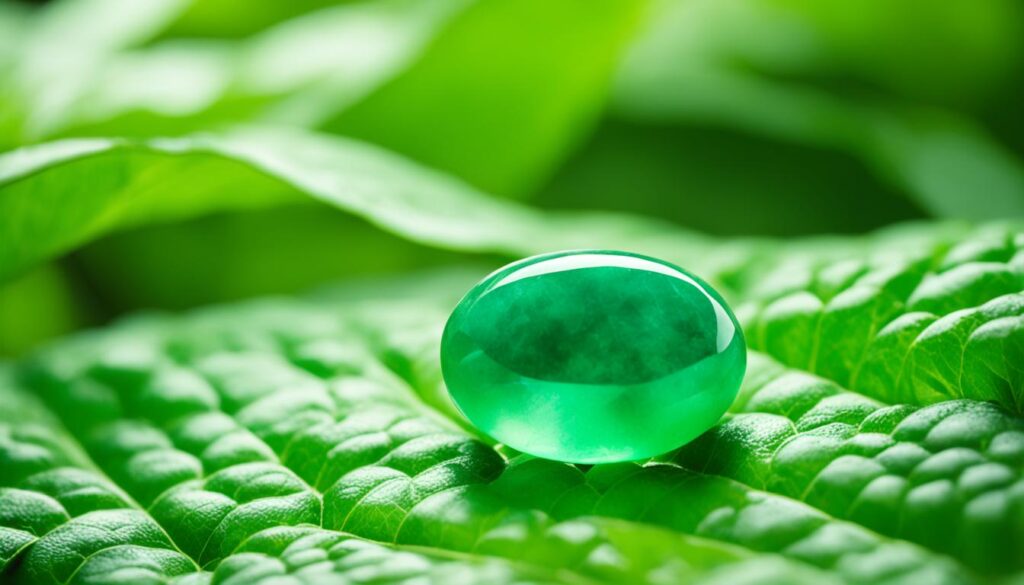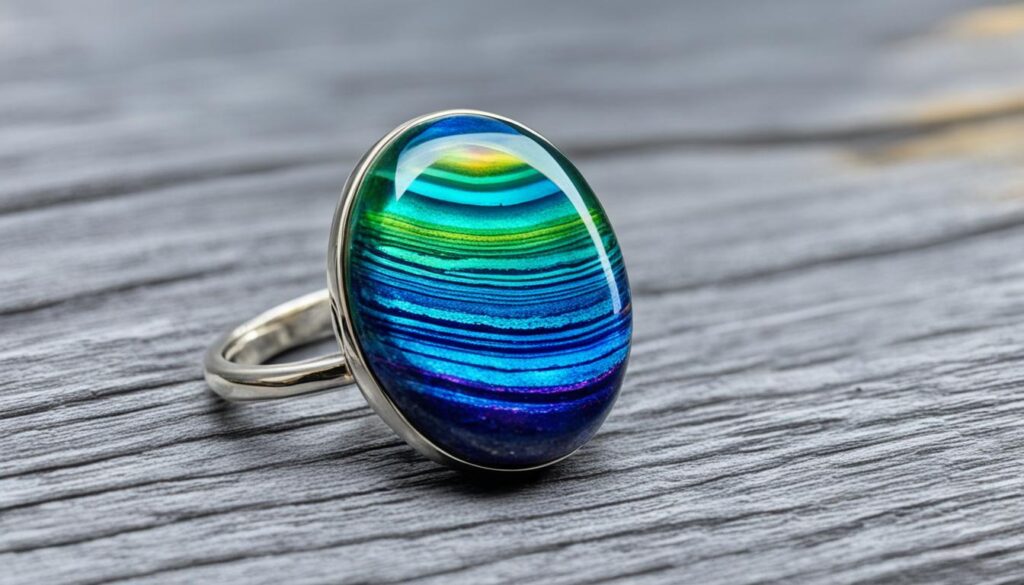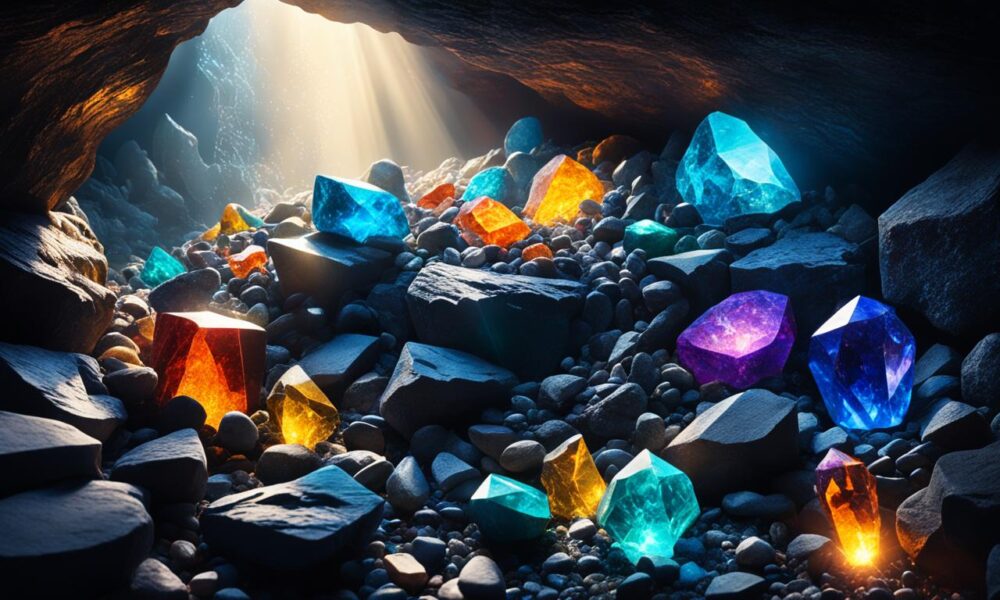Discover the Rarest Natural Stone Gems
If you’re in search of something truly unique and exquisite for your next jewelry purchase, look no further than the rarest natural stone gems. These gems possess a beauty and charm that is unparalleled, making them a trove for enthusiasts and collectors alike.
While diamonds may be the go-to gemstone for many, there are precious stones even rarer and more captivating than diamonds. These stunning gems are highly sought after for their scarcity, unique colors, and exceptional quality.
Key Takeaways:
- The rarest natural stone gems are highly valued for their unique beauty.
- These gems are a treasure trove for enthusiasts and collectors.
- They possess exquisite colors and exceptional quality.
- Diamonds, although widely popular, are surpassed in rarity by these stunning gems.
- Consider these rare gems for your next jewelry purchase to truly stand out.
Tanzanite – A Surprising Rarity
Tanzanite, a rare gemstone, possesses intense violet-blue hues that rival even the finest sapphires. Its unique colors and limited availability make it highly prized among gemstone enthusiasts and collectors. Since its discovery in 1967 and the successful marketing campaigns by Tiffany & Co., tanzanite has gained widespread popularity.
Mined exclusively in a small region of Tanzania, tanzanite is considered one of the rarest gemstones. Its scarcity adds to its desirability, as it is estimated that the mines will be completely depleted within the next few decades. The allure and rarity of tanzanite make it a truly exceptional addition to any jewelry collection.
Burma Ruby – Setting the Standard
Rubies from Myanmar, also known as Burma, are highly sought after for their exceptional quality and captivating color. These rare gems are renowned for their vivid red hue, often surpassing rubies from other sources. One of the distinguishing features of Burma rubies is their strong fluorescence, which adds to their allure and sets them apart from other rubies.
While top-quality Thai rubies can rival those from Myanmar in terms of color and clarity, the “pigeon blood” red exhibited by Burma rubies is particularly coveted. Their intense reds, coupled with a distinct fluorescence, create a mesmerizing and vibrant gemstone that captivates the imagination of both enthusiasts and collectors.
Here is a detailed breakdown of the exceptional qualities of Burma rubies:
| Characteristic | Description |
|---|---|
| Rarity | Burma rubies are exceptionally scarce, making them highly valued in the gemstone market. |
| Vivid Reds | These rubies often achieve more intense and vibrant shades of red compared to rubies from other sources. |
| Strong Fluorescence | The distinct fluorescence exhibited by Burma rubies adds to their visual appeal and sets them apart from other rubies. |
In summary, Burma rubies are a testament to the remarkable beauty and allure of natural gemstones. Despite the competition from rubies sourced from other regions such as Thailand, Burma rubies continue to captivate gemstone enthusiasts with their rare combination of vivid reds and strong fluorescence.
Jadeite – Prized in Different Cultures
Jadeite, known for its vibrant green color, is a gemstone highly valued in various cultures for its bright colors, extensive folklore, and subjective value. Not only does jadeite display a stunning range of green shades, but it can also be found in other vibrant colors such as lavender, yellow, and white.

In Chinese culture, jadeite has been revered for centuries and is believed to possess protective properties and bring good luck and fortune. It is often carved into intricate shapes and symbols, representing different meanings and intentions. From imperial court jewelry to personal amulets, jadeite has played a significant role in Chinese traditions.
“Gold has value; jade is invaluable” – Chinese proverb
Jadeite also holds great cultural significance in other parts of the world. In Mayan civilization, this gemstone symbolized life, fertility, and power. It was often incorporated into ceremonial masks, jewelry, and spiritual artifacts. Similarly, in Maori culture, jadeite, known as pounamu or greenstone, holds deep spiritual and cultural importance and is traditionally used for carving intricate designs.
The value of jadeite extends beyond its physical properties. Its subjective value lies in its translucence, texture, and overall artistry. The craftsmanship, intricacy, and meaning behind jadeite pieces contribute to their allure and collectible status.
Whether you appreciate jadeite for its vibrant colors, rich folklore, or subjective value, this gemstone continues to fascinate and captivate enthusiasts and collectors around the world. Its unique beauty and cultural significance make jadeite truly exceptional.
Alexandrite – The Color Chameleon
Alexandrite is a remarkable gemstone known for its color-changing abilities. This captivating stone displays a mesmerizing transformation from green to blue in daylight and from red to purple in incandescent light. Its ability to change colors depending on the lighting conditions makes it truly unique and alluring.
Named after Czar Alexander II of Russia, alexandrite is still considered rare and highly coveted by gemstone enthusiasts and collectors worldwide. Despite being discovered in additional locations, genuine alexandrite remains a rarity, adding to its desirability.
Due to its popularity and scarcity, synthetic alternatives of alexandrite have been produced. While these synthetic versions may possess similar color-changing abilities, they lack the rarity and natural appeal of genuine alexandrite.
Experience the mesmerizing charm of alexandrite, a gemstone that shifts its colors like the changing shades of a chameleon.
Paraíba Tourmaline – Neon Beauty
Paraíba tourmaline stunned the gem world with its bright blue-green hues. This exquisite gemstone captivates with its vibrant and electrifying colors, resembling the beauty of a tropical paradise. Initially discovered in the Paraíba region of Brazil, paraíba tourmaline has also been found in Mozambique and Nigeria, albeit in smaller quantities.
The mesmerizing bright blue-green color of paraíba tourmaline is a result of copper and manganese trace elements found within the gemstone. This combination creates a unique fluorescence that intensifies its brilliance.
“Paraíba tourmaline is like a neon light in the gem world, radiating unmatched beauty and breathtaking charm.”
What makes paraíba tourmaline even more desirable is its scarcity. The gemstone is incredibly rare, with only limited deposits discovered so far. This scarcity adds to its allure and contributes to its high value in the market. The restricted supply of paraíba tourmaline has led to increased demand among collectors and enthusiasts around the globe.
In recent years, alternative sources of paraíba tourmaline have been discovered, notably in Mozambique and Nigeria. While these new deposits have helped meet the demand for this extraordinary gemstone, they still cannot match the quantity and quality of the original Paraíba region in Brazil.
Precious Characteristics of Paraíba Tourmaline
To fully appreciate the allure of paraíba tourmaline, here are some of its noteworthy characteristics:
- Rarity: Paraíba tourmaline is an exceptionally rare gemstone, making it a prized treasure among gem enthusiasts.
- Bright Blue-Green Color: The vibrant and intense bright blue-green color of paraíba tourmaline is truly unique and mesmerizing.
- Exceptional Brilliance: The gemstone’s fluorescence enhances its brilliance, causing it to radiate vibrant hues under various lighting conditions.
- Neon-Like Glow: Paraíba tourmaline’s incredible luminosity gives it a striking neon-like glow, setting it apart from other gemstones.
- Collectible Beauty: Due to its rarity and beauty, paraíba tourmaline is highly sought after by collectors who value its unique qualities.
Paraíba tourmaline is a gemstone that embodies the perfect blend of rarity, vibrant colors, and exceptional beauty. Its bright blue-green hues continue to captivate the world, making it a true gemstone treasure.
Ammolite – A Rainbow from the Sea
Ammolite, an organic gem formed from the fossilized shells of marine mollusks, mesmerizes with its vibrant iridescent colors. This unique gemstone showcases an exquisite array of hues that often resemble a beautiful rainbow. The allure of ammolite lies not only in its breathtaking appearance but also in its limited availability.
Found in limited deposits nestled within the Rocky Mountains, ammolite is significantly rarer than diamonds. Each piece of ammolite is a true marvel of nature, displaying remarkable organic patterns and vibrant colors that make it a highly sought-after gemstone.
“Ammolite is a mesmerizing gemstone that captivates with its iridescent colors, reminiscent of a vibrant rainbow. Its limited deposits and organic origin make it a truly unique and valuable gem in the world of jewelry.”
The value of ammolite is influenced by the rarity of its colors and the intensity of its iridescence. Gem enthusiasts and collectors prize ammolite for its ability to create stunning pieces of jewelry that radiate with iridescent beauty.
Discover the captivating allure of ammolite in the image below:

| Characteristics | Values |
|---|---|
| Origin | Marine mollusk fossils |
| Colors | Iridescent; varied hues |
| Availability | Limited deposits in the Rocky Mountains |
| Rarity | Significantly rarer than diamonds |
Whether you’re a gemstone enthusiast, a collector, or someone who simply appreciates the beauty of unique organic gems, ammolite is a true marvel. Its stunning iridescent colors and limited availability make it a precious gem that deserves to be cherished and admired.
Kashmir Sapphire – Velvety Blue Beauty
Kashmir sapphires are renowned for their velvety, saturated blue hues. These exquisite gems possess a softness in their appearance, attributed to the presence of very fine inclusions. The allure of Kashmir sapphires lies in their rarity and unmatched quality, making them highly sought after by gem enthusiasts and collectors alike.
Once extracted from the mines nestled in the Himalayas, Kashmir sapphires captivated the world with their mesmerizing beauty. However, the mining operations in this remote region came to an end in the 1930s, depleting the resources of this coveted gemstone. As a result, Kashmir sapphires became increasingly scarce, making them a true treasure for those fortunate enough to possess one.
Today, Kashmir sapphires are considered museum-worthy, as their exceptional quality and scarcity make them a rare sight outside prestigious galleries. The soft blue hues of these sapphires evoke a sense of elegance and sophistication, making them a cherished addition to any jewelry collection.
In conclusion, Kashmir sapphires represent the epitome of timeless beauty and sophistication, with their velvety blue hues and rarity. These museum-worthy gemstones continue to captivate the world with their unparalleled charm and remain an everlasting symbol of elegance.
Natural Pearl – Rarity from the Ocean
Natural pearls are a scarce and highly sought-after gem formed by nature’s exquisite artistry. These pearls are becoming even rarer due to overfishing, pollution, and the detrimental effects of ocean acidification.
Unlike cultured pearls which are intentionally grown, natural pearls occur spontaneously and are rarely found in our planet’s oceans. They are a true miracle of nature, created when an irritant such as a grain of sand or a parasite enters the soft tissue of a mollusk. In response, the mollusk secretes layers of nacre around the irritant, resulting in the formation of a beautiful pearl.
Natural pearls have fascinated humanity for centuries and hold a special place in the world of jewelry. They possess a unique beauty that cannot be replicated, making them highly valued and cherished. One can find natural pearls adorning the most exceptional antique jewelry pieces, adding a touch of history and elegance.
It is important to note that natural pearls are rarely perfectly round and often possess imperfections and off-colors, known as “pearl blemishes.” These imperfections, though considered flaws in some gemstones, add to the charm and authenticity of natural pearls, showcasing their organic origins and individuality.
“Natural pearls are a testament to the beauty and resilience of the ocean’s ecosystem. Their scarcity and imperfections remind us of the delicate balance we must strive to maintain.”
Magnificent Pearls in Antique Jewelry
Antique jewelry often showcases the exquisite beauty of natural pearls. From Victorian-era necklaces to Art Deco earrings, pearls have adorned countless masterpieces throughout history. Antique lovers and collectors treasure these pieces not only for their timeless appeal but also for the unique stories they hold.
Celebrities Embrace the Imperfections
Even in modern times, natural pearls continue to captivate and inspire. Celebrities such as Marilyn Monroe, Audrey Hepburn, and Jackie Kennedy have embraced the allure of natural pearls, recognizing their uniqueness and imperfections as a mark of authenticity and individuality.
Whether it’s the lustrous glow or the surface imperfections, natural pearls possess a charm that cannot be replicated by any other gemstone. Their rarity and classic elegance make them a true treasure from the depths of the ocean.
| Pearl Type | Origin | Rarity |
|---|---|---|
| Akoya Pearls | Japan | Relatively Rare |
| South Sea Pearls | Australia, Indonesia, Philippines | Rare |
| Tahitian Pearls | Tahiti, French Polynesia | Rare |
| Basra Pearls | Persian Gulf | Extremely Rare |
Red Beryl – The Rare Red Gem
Red beryl, also known as bixbite, is a stunning gemstone that belongs to the same family as emerald and aquamarine. What sets it apart is its vibrant bright red hue, which is attributed to the presence of manganese. This rare red gem is highly desired by collectors and enthusiasts worldwide.
Gem-quality red beryl is extremely scarce, making it one of the rarest gemstones in existence. Due to its extreme rarity, most red beryl specimens are kept by mineral collectors and never faceted into jewelry. The few red beryl gemstones that are cut and polished are considered treasures due to their unmatched beauty and scarcity.
It’s important to note that red beryl, like many other gemstones, can occur in lower-quality specimens. These specimens may have visible flaws, cloudy appearance, or a lighter color. However, even these lower-quality red beryl stones still possess a unique charm and beauty that is highly sought after by collectors.
Fascinating Facts about Red Beryl:
- Red beryl is also known as “red emerald” due to its color and similarity to emerald.
- It was discovered in Utah, USA, in the early 1900s and is primarily found in the Wah Wah Mountains and Thomas Range.
- Red beryl is so rare that it is estimated that for every 150,000 diamonds mined, only a single red beryl is found.
“The allure of red beryl lies in its captivating red hue and its exceptional rarity, making it a true treasure in the world of gemstones.” – Gemstone Enthusiast
Benitoite – Rarity from California
Benitoite is an extraordinary gemstone that surpasses the rarity of diamonds. Its exceptional beauty, intense brilliance, and stunning sapphire-blue color have captivated collectors and enthusiasts worldwide. Found exclusively in San Benito County, California, benitoite is truly a gem of unparalleled rarity and allure.
With a remarkable “fire” or dispersion that exceeds that of diamonds, benitoite exhibits a breathtaking play of color when exposed to light. Its intense brilliance makes it a coveted gemstone that stands out among the rest. Whether set in a ring, pendant, or earrings, benitoite’s vibrant blue hues are sure to capture attention and leave a lasting impression.
One of the most intriguing aspects of benitoite is its limited availability. As the only known source of this gemstone, the mines in San Benito County are the sole producers of benitoite in the world. This exclusivity adds to its desirability, making it a prized treasure for collectors and gemstone connoisseurs.
Color Options
Benitoite is predominantly known for its mesmerizing sapphire-blue color, which ranges in shades from light to deep blue. However, it’s worth noting that benitoite can also exhibit color variations such as purple, violet, and even colorless, although these variants are extremely rare.
Below is a table showcasing some of the color options available in benitoite:
| Color | Description |
|---|---|
| Sapphire Blue | The classic and most sought-after color of benitoite. |
| Purple | A vibrant and rare color variant, captivating with its deep purple tones. |
| Violet | A delicate and enchanting color option, showcasing hues of violet and blue. |
| Colorless | A unique and exceptionally rare attribute, showcasing the gem’s transparency. |
The rarity and distinctiveness of benitoite make it an extraordinary gemstone that stands out in the world of jewelry. Its scarcity, intense brilliance, and vibrant color options make it a truly exceptional choice for those seeking a one-of-a-kind gem.
Conclusion
In the world of gemstones, the rarest natural stone gems stand out as true treasures. Their unique beauty and allure captivate the hearts and imaginations of enthusiasts and collectors alike. From the stunning violet-blue hues of tanzanite to the vibrant green shades of jadeite, these gems are exceptionally prized.
As we’ve explored the world of rare gemstones, we’ve encountered incredible finds like benitoite with its intense brilliance and sapphire-blue color, and red beryl, a scarce gem that rivals the beauty of diamonds. These rare gems are truly exceptional, each with its distinct characteristics and allure that make them highly sought after.
With their scarcity and one-of-a-kind qualities, the rarest natural stone gems have become coveted treasures. They embody the essence of uniqueness and stand as a testament to the wonders of the Earth. Whether adorning a piece of jewelry or displayed in a collection, these gems offer a glimpse into the mesmerizing beauty of the natural world.



